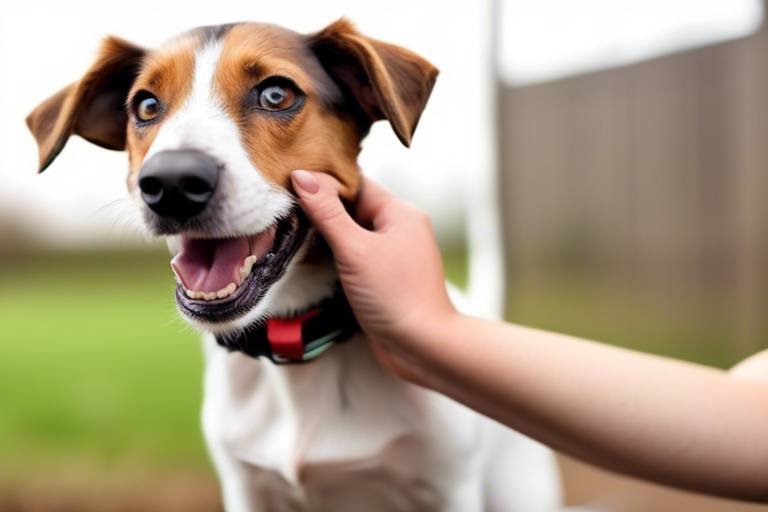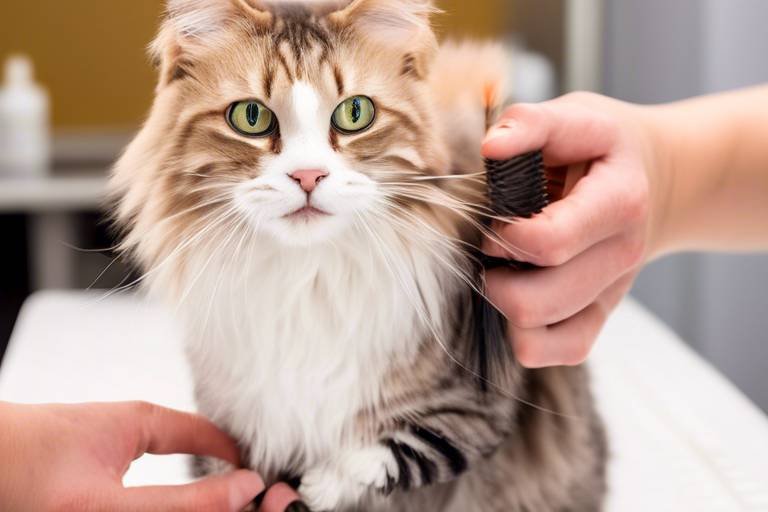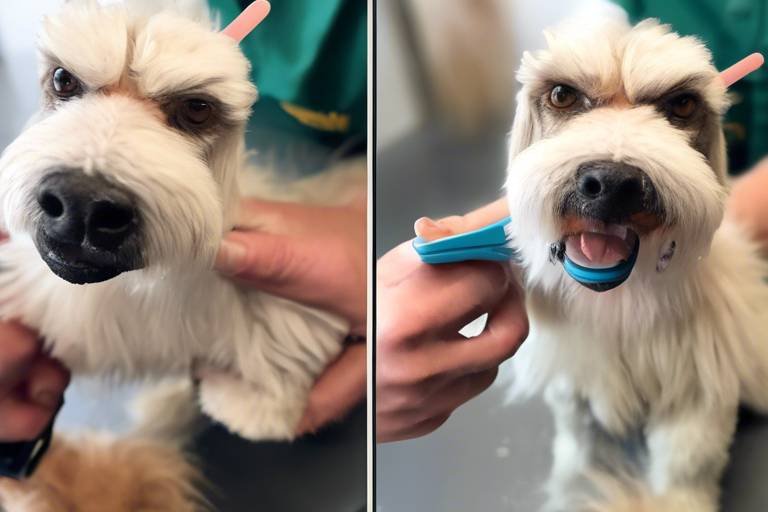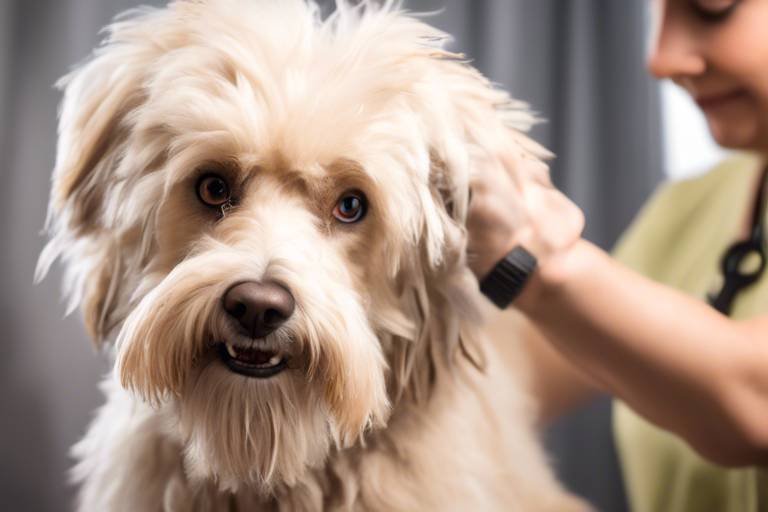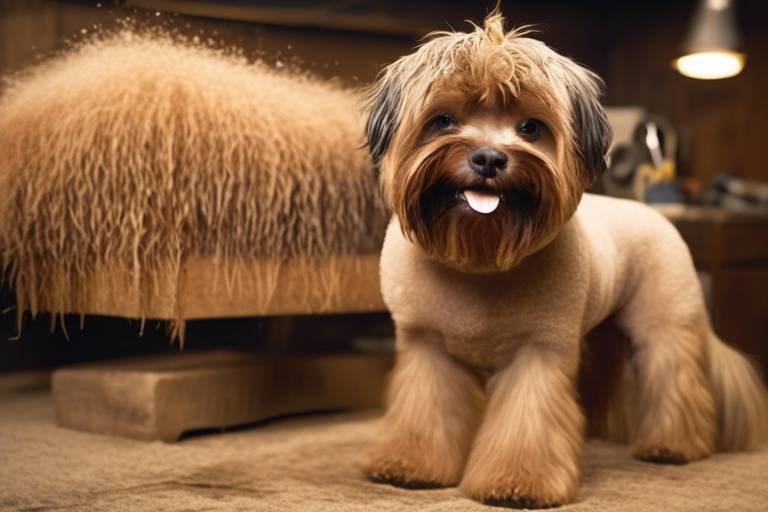The Role of Grooming in Reducing Anxiety in Rescue Pets
When it comes to our beloved rescue pets, grooming is more than just a way to keep them looking good; it plays a crucial role in their emotional health. Imagine for a moment how a gentle brush can transform a scruffy coat into a shiny, healthy one. But it's not just about aesthetics! Grooming offers a myriad of benefits that can significantly alleviate anxiety in these animals, helping them adjust to their new homes and lives. Just like us, pets can feel overwhelmed and stressed, especially after experiencing trauma or instability. By incorporating regular grooming into their routine, we can provide them with a sense of security and comfort that is essential for their mental well-being.
Grooming can serve as a bonding experience, creating a nurturing environment where rescue pets feel safe and cared for. Think of it as a form of love language; it’s an opportunity for pet owners to connect with their furry companions on a deeper level. This connection not only helps to build trust but also reinforces a sense of routine, which is particularly beneficial for pets that may have experienced chaos in their previous lives. In many ways, grooming is like a warm hug—it's a simple act that can make a world of difference.
Moreover, the act of grooming itself can be inherently soothing. The rhythmic motion of brushing or bathing can mimic the gentle caresses that many pets crave. This can help to lower stress levels and promote relaxation. It's important to remember that rescue animals often come with their own unique sets of challenges, and grooming can be an effective tool in managing these issues. By fostering a calm environment during grooming sessions, we can help our pets feel more at ease, gradually reducing their anxiety levels over time.
In summary, grooming is not just a chore; it is a vital practice that can significantly enhance the emotional well-being of rescue pets. By understanding the profound impact grooming can have, we can better support our furry friends in their journey toward healing and happiness. So, the next time you pick up that brush, remember: you’re not just grooming your pet; you’re helping to build a bridge of trust and comfort that can lead to a happier, healthier life together.
- How often should I groom my rescue pet? The frequency of grooming depends on the breed and coat type. Generally, long-haired breeds may require grooming several times a week, while short-haired breeds may need it less frequently.
- Can grooming really help reduce anxiety? Yes! Regular grooming sessions can create a calming routine and help build trust between the pet and owner, significantly reducing anxiety levels.
- What should I do if my rescue pet is scared of grooming? Start slowly by introducing grooming tools gradually and using positive reinforcement to encourage calm behavior. If anxiety persists, consider consulting a professional groomer.
- Are there specific grooming techniques for anxious pets? Yes! Gentle brushing, using soothing voices, and providing treats can create a more positive grooming experience for anxious pets.
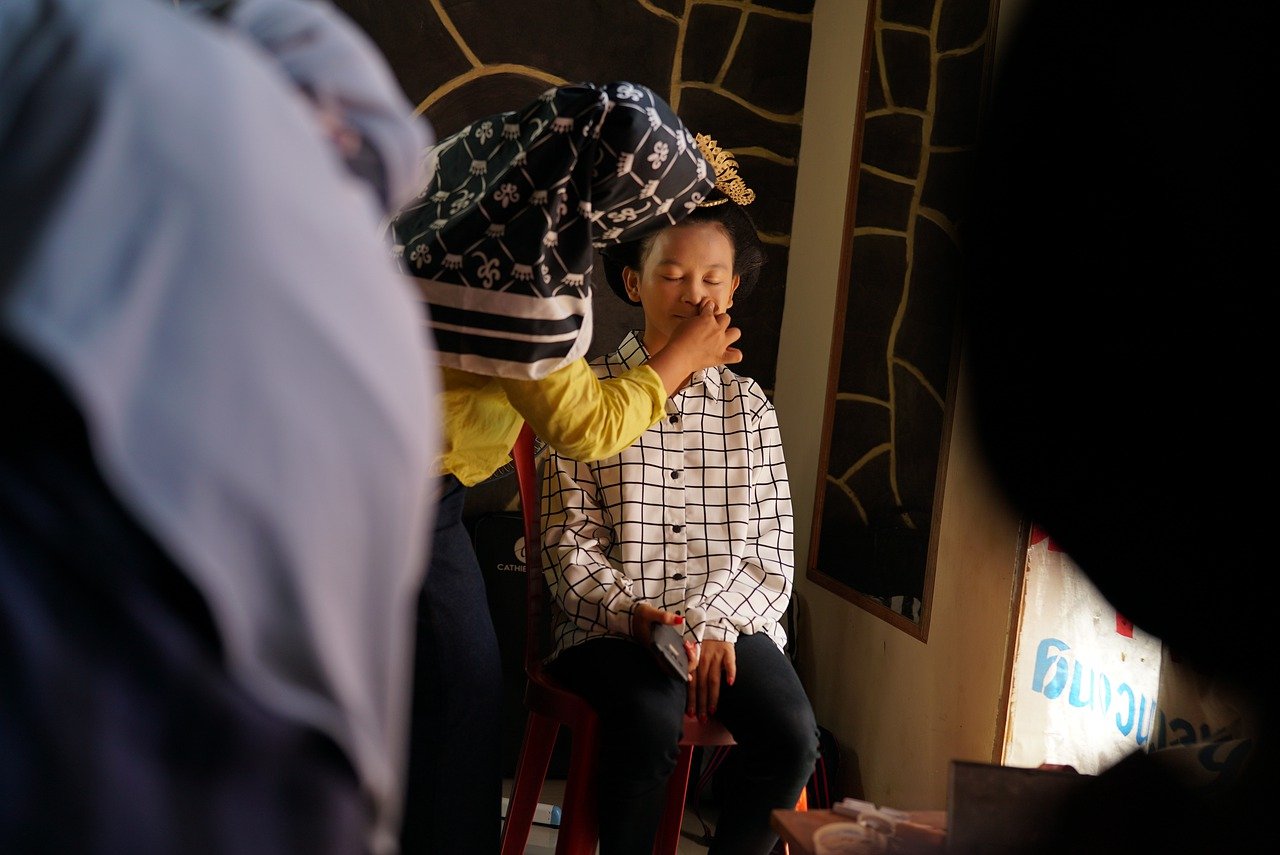
The Importance of Grooming for Rescue Pets
Grooming is not just about keeping our furry friends looking their best; it plays a vital role in the overall health and well-being of rescue pets. For animals that have faced abandonment or neglect, grooming can serve as a therapeutic experience that promotes hygiene and comfort while also providing emotional benefits that can significantly ease anxiety and stress. Just like humans feel refreshed after a good shower or a haircut, pets can experience similar relief through regular grooming sessions.
When we think about grooming, we often picture brushing fur, trimming nails, or cleaning ears. However, the benefits extend far beyond aesthetics. For rescue pets, grooming can help establish a sense of routine and predictability in their lives, which is crucial for animals that may have experienced chaos or instability in their past. This predictability can create a safe haven for them, allowing their anxiety to gradually dissipate.
Moreover, grooming sessions provide an opportunity for bonding between the pet and their new owner. During these sessions, pet owners can develop a deeper understanding of their furry companions, recognizing their likes and dislikes, and learning how to communicate effectively. This connection is especially important for rescue pets, who may need extra reassurance and patience as they adjust to their new environment.
In addition to emotional benefits, grooming also promotes physical health. Regular brushing helps to remove dirt, debris, and loose fur, which can prevent skin irritations and matting. It also stimulates circulation, leading to healthier skin and a shinier coat. Furthermore, grooming allows owners to check for any abnormalities, such as lumps or skin infections, ensuring that their pets remain in top shape.
To summarize the importance of grooming for rescue pets, consider the following key benefits:
- Promotes Hygiene: Regular grooming keeps pets clean and helps prevent health issues.
- Reduces Anxiety: A calming grooming routine can significantly lower stress levels.
- Strengthens Bond: Grooming builds trust and enhances the relationship between pet and owner.
- Encourages Routine: Establishing a grooming schedule provides stability for anxious pets.
In conclusion, grooming is an essential part of caring for rescue pets. It goes beyond mere appearance; it fosters emotional well-being, enhances physical health, and strengthens the bond between pet and owner. By incorporating regular grooming into their routine, pet owners can help their rescue animals feel more secure and loved, paving the way for a happier, healthier life together.
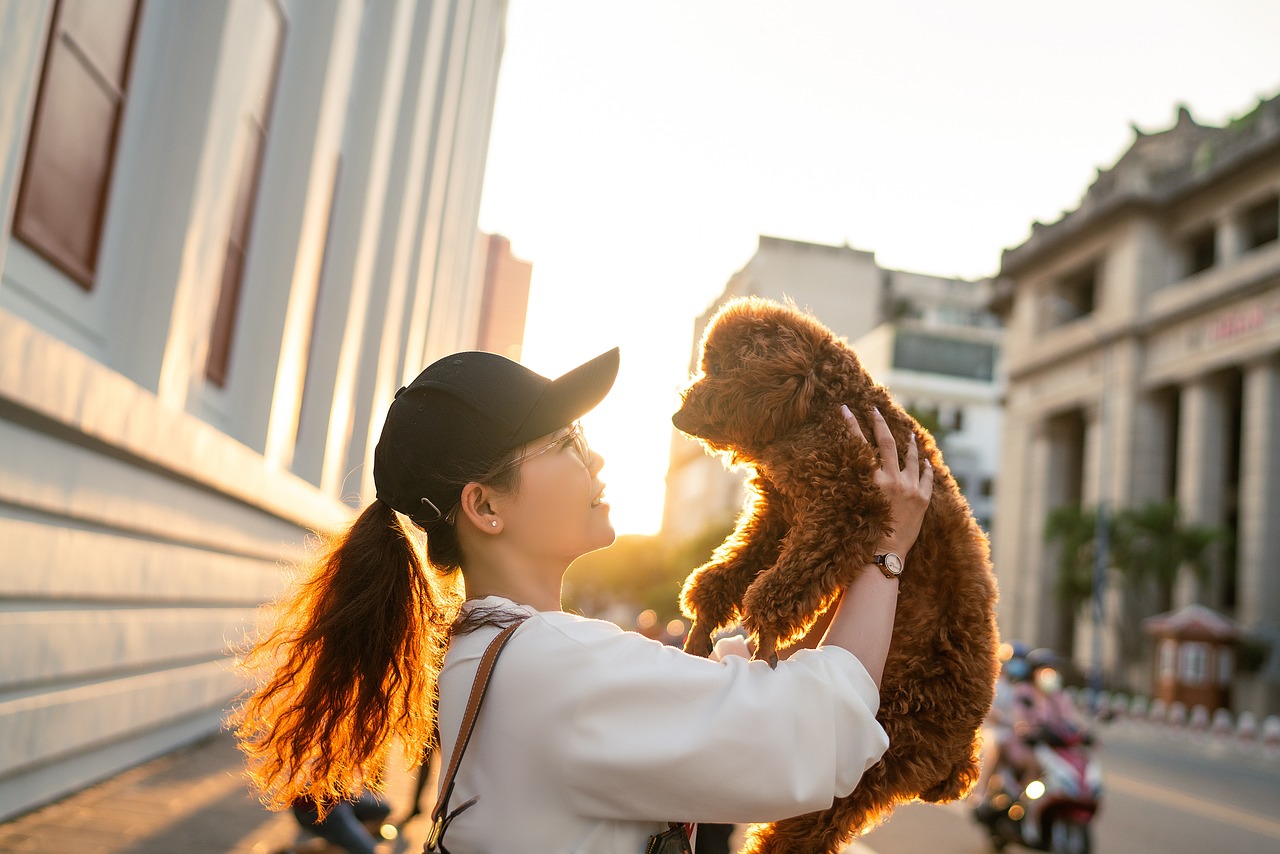
When it comes to rescue pets, understanding their emotional landscape is absolutely crucial. Many of these animals have endured traumatic experiences, which can leave them feeling anxious and unsure in their new environments. Just like us, pets can carry emotional baggage, and it’s our job as their new guardians to help them unpack it. So, how do we recognize what’s going on in their furry little heads? It starts with understanding the signs of anxiety and the factors that contribute to it.
First off, let’s talk about the common behaviors exhibited by anxious pets. You might notice your new furry friend trembling at the slightest noise or hiding under the couch when guests come over. These behaviors can be alarming, but they are often a cry for help. It’s important to remember that anxiety in pets can manifest in both physical and behavioral ways. For instance, a dog that suddenly becomes aggressive or starts barking excessively may be trying to express its discomfort.
So, what exactly causes this anxiety? Well, it can be a mix of factors, including:
- Past Trauma: Many rescue pets come from abusive or neglectful situations, which can leave lasting scars.
- Lack of Socialization: Pets that haven’t been properly socialized may struggle to adapt to new people or environments.
- Environmental Changes: Moving to a new home can be overwhelming for a pet, especially if they are not used to new sights, sounds, or smells.
By recognizing these signs and understanding their causes, we can better support our rescue pets in their journey to feeling safe and secure. It’s like being a detective in their emotional world, piecing together clues to understand their needs. The more we know, the better equipped we are to help them thrive.
In the next sections, we’ll dive deeper into the benefits of grooming and how it can play a significant role in alleviating anxiety. After all, a well-groomed pet is not just a pretty face; it’s a happier, more relaxed companion!
Q: How can I tell if my rescue pet is anxious?
A: Look for signs like trembling, excessive barking, hiding, or destructive behavior. If your pet shows these signs, it may be experiencing anxiety.
Q: Can grooming really help reduce my pet's anxiety?
A: Yes! Regular grooming can create a calming routine and help build trust between you and your pet, which can significantly reduce anxiety levels.
Q: What should I do if my pet is too anxious for grooming?
A: Start slowly by introducing grooming tools and techniques gradually. If needed, consult a professional groomer who specializes in anxious pets.
Understanding the common signs of anxiety in rescue pets is crucial for any pet owner who wants to ensure their furry friend feels safe and secure in their new environment. Just like humans, pets can exhibit a variety of behaviors that signal they are feeling anxious or stressed. These signs can range from subtle changes in behavior to more overt actions that indicate distress. By recognizing these signs early, you can take proactive steps to help your pet feel more comfortable.
One of the most noticeable indicators of anxiety in rescue pets is physical symptoms. These may include trembling, excessive panting, or even hiding away in a corner. For instance, if you notice your dog shaking during a thunderstorm or your cat retreating to a dark space when guests arrive, these are clear signs that they are feeling anxious. Understanding these physical manifestations can help you create a safe haven for your pet, allowing them to retreat when they feel overwhelmed.
In addition to physical symptoms, you should also be aware of behavioral symptoms. These can include aggression, excessive barking, or destructive behaviors, which often signal that your pet is feeling anxious. For example, a previously calm dog may start barking excessively or chewing furniture when left alone, indicating separation anxiety. Similarly, a cat might scratch furniture or refuse to eat when feeling stressed. Recognizing these behavioral changes is essential for developing appropriate coping strategies to help your pet manage their anxiety.
It's also important to consider the context in which these signs appear. For instance, if your pet shows signs of anxiety during specific situations, such as car rides or vet visits, it may indicate a fear associated with those experiences. This understanding can guide you in creating positive associations with these situations, such as using treats or toys to make them feel more comfortable.
In summary, being vigilant about the signs of anxiety in rescue pets can significantly impact their emotional well-being. By observing both physical and behavioral symptoms, you can better address your pet's needs and foster a nurturing environment. Remember, a calm pet is a happy pet, and your attentiveness can make all the difference in their adjustment to a new home.
- What are some common signs of anxiety in rescue pets? Common signs include trembling, excessive barking, hiding, and destructive behaviors.
- How can I help my anxious pet? Establishing a consistent routine, providing a safe space, and using positive reinforcement can help alleviate anxiety.
- When should I seek professional help for my pet's anxiety? If your pet's anxiety is severe or persistent, consulting a professional trainer or veterinarian may be beneficial.
When it comes to understanding the emotional state of rescue pets, recognizing physical symptoms of anxiety is crucial. These signs can often be the first indicators that a pet is struggling with their mental well-being. For instance, you might notice your furry friend trembling or shaking even in a seemingly safe environment. This involuntary reaction is their body’s way of expressing discomfort, and it’s essential to address it promptly.
Another common physical symptom is excessive panting. While panting can occur due to heat or exercise, if your pet is panting heavily while resting or in a calm setting, it could be a sign of anxiety. Additionally, many anxious pets tend to seek refuge in tight spaces or corners, often hiding to escape what they perceive as threats. This behavior is a clear indication that something is amiss in their emotional landscape.
Moreover, you might observe changes in their appetite. An anxious pet may eat less than usual or completely refuse food, which can lead to further health issues if not addressed. Furthermore, some pets might display hyperactive behaviors, such as pacing or incessantly licking themselves, as a way to cope with their anxiety. These physical manifestations are not just fleeting moments; they can significantly impact a pet's overall health and happiness.
To help you better understand these physical symptoms, here’s a quick table summarizing the most common signs of anxiety in rescue pets:
| Physical Symptom | Description |
|---|---|
| Trembling | Involuntary shaking, often seen in stressful situations. |
| Excessive Panting | Heavy breathing that occurs without physical exertion. |
| Hiding | Seeking refuge in small spaces to escape perceived threats. |
| Loss of Appetite | Refusing food or eating significantly less than usual. |
| Hyperactivity | Pacing or excessive grooming as a coping mechanism. |
Understanding these physical symptoms is the first step in providing the support and care that rescue pets need. By being attentive to their behaviors, you can better address their anxiety and help them feel more secure in their new environment.
- What should I do if my rescue pet shows signs of anxiety? It's essential to consult with a veterinarian or an animal behaviorist who can provide tailored advice and strategies.
- Can grooming help reduce anxiety in my pet? Yes, grooming can create a calming routine and strengthen the bond between you and your pet, which may alleviate anxiety.
- How often should I groom my rescue pet? Regular grooming is important; the frequency depends on the breed and coat type, but a general rule is every 4-6 weeks.
- Are there specific grooming tools for anxious pets? Yes, choosing gentle, quiet tools can make the grooming experience more comfortable for anxious pets.
Understanding the behavioral symptoms of anxiety in rescue pets is a vital step in ensuring their well-being. Just like humans, pets can exhibit a range of behaviors when they feel stressed or anxious. These behaviors often serve as a cry for help, signaling that something is amiss in their emotional state. For instance, you might notice your furry friend acting out in ways that are uncharacteristic of their usual demeanor. Common behavioral symptoms include:
- Aggression: Some rescue pets may display aggression, which can manifest as growling, biting, or lunging. This behavior is often a defense mechanism stemming from fear or anxiety.
- Excessive Barking: Barking can be a way for pets to express their discomfort. If your rescue dog seems to bark more than usual, it might be their way of communicating their anxiety.
- Destructive Actions: Anxious pets may resort to destructive behaviors, such as chewing furniture or scratching at doors. This can be a sign of frustration or an attempt to escape their discomfort.
- Withdrawal: Some pets may choose to isolate themselves when anxious, hiding in corners or under furniture. This withdrawal is a clear indication that they are feeling overwhelmed.
These behavioral symptoms can be alarming for pet owners, as they often disrupt the bond between the pet and their human. Recognizing these signs is crucial for developing effective coping strategies. For example, if your pet is exhibiting aggression, it may be beneficial to consult with a professional trainer or behaviorist who can guide you on how to manage their anxiety effectively. Remember, patience and understanding are key when addressing these behaviors.
Moreover, it's essential to consider the context of these behaviors. A pet that has recently transitioned into a new home might display anxiety due to the unfamiliar environment. In such cases, creating a safe and comforting space can help alleviate their distress. Offering consistent routines, gentle reassurance, and plenty of love can go a long way in helping your rescue pet feel more secure.
In conclusion, being aware of these behavioral symptoms is the first step in addressing anxiety in rescue pets. By taking the time to understand and respond to their needs, you can help your furry friend lead a happier, healthier life. And remember, you're not alone in this journey. Many pet owners face similar challenges, and there are numerous resources available to help you navigate the complexities of pet anxiety.
Q: How long does it take for a rescue pet to adjust to a new home?
A: The adjustment period can vary significantly based on the individual pet's background and personality. Some pets may adapt within a few days, while others might take weeks or even months. Patience is crucial during this time.
Q: Can grooming help with my pet's anxiety?
A: Absolutely! Regular grooming can provide a comforting routine and help build trust between you and your pet. It can also serve as a calming activity that promotes relaxation.
Q: What should I do if my pet shows signs of severe anxiety?
A: If your pet exhibits severe anxiety, it is advisable to consult with a veterinarian or a professional animal behaviorist. They can help identify the underlying causes and recommend appropriate interventions.
Q: Are there specific grooming techniques that help anxious pets?
A: Yes! Gentle brushing, using calming scents, and incorporating positive reinforcement can make grooming a more enjoyable experience for anxious pets. Always choose tools that are suitable for your pet's coat type.
Understanding the causes of anxiety in rescue pets is crucial for any pet owner who wants to provide a loving and supportive environment. These animals often come from backgrounds filled with trauma, neglect, or instability, which can leave lasting emotional scars. Just like humans, pets can experience a range of emotions, and anxiety can manifest in various ways. Some common factors contributing to anxiety in rescue pets include:
- Past Trauma: Many rescue pets have experienced abuse or abandonment, leading to heightened sensitivity to certain situations. This trauma can create a fear response that may be triggered by loud noises, sudden movements, or unfamiliar environments.
- Lack of Socialization: Pets that haven’t been properly socialized during their formative months may struggle to adapt to new people, animals, or experiences. This lack of exposure can result in a fearful disposition, making them more prone to anxiety.
- Environmental Changes: Moving to a new home can be overwhelming for any pet. The unfamiliar smells, sounds, and routines can trigger stress and anxiety, particularly if the pet has not had time to adjust.
- Health Issues: Sometimes, anxiety can be exacerbated by underlying health problems. Conditions such as pain, illness, or discomfort can make pets irritable and more susceptible to anxiety.
It’s essential for pet owners to be observant and recognize these factors. By understanding the roots of their pet's anxiety, owners can take proactive steps to create a safe and nurturing environment. This might include gradual introductions to new experiences, providing a consistent routine, or even consulting with a veterinarian for potential health-related concerns. Each pet is unique, and what works for one may not work for another, but empathy and patience can go a long way in easing their fears.
In the end, being aware of these causes not only helps in addressing the immediate symptoms but also fosters a deeper bond between the pet and owner. This bond is built on trust, understanding, and the shared goal of achieving a more peaceful and happy life together.
Q: How can I tell if my rescue pet is anxious?
A: Look for signs such as excessive barking, hiding, trembling, or changes in appetite. If your pet exhibits these behaviors, it may be experiencing anxiety.
Q: What should I do if my rescue pet shows signs of anxiety?
A: It's important to create a calm environment, establish a routine, and use positive reinforcement. If the anxiety persists, consider consulting a veterinarian or a professional trainer.
Q: Can grooming help reduce my rescue pet’s anxiety?
A: Yes! Regular grooming can provide a soothing experience, build trust, and help your pet feel more comfortable and secure in their new environment.
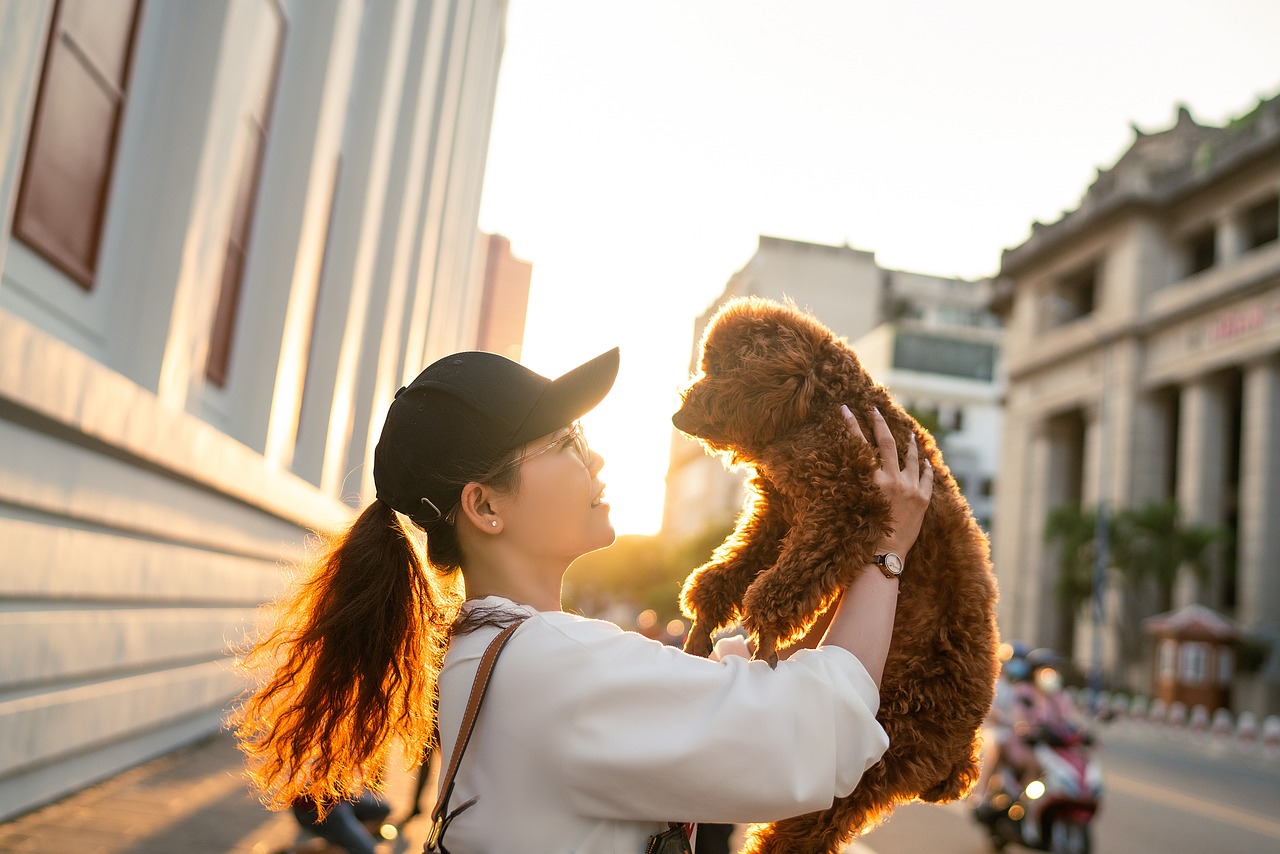
Regular grooming is not just about keeping your rescue pet looking fabulous; it's a crucial component of their overall health and well-being. Think of grooming as a spa day for your furry friend—it's an opportunity for them to relax, bond with you, and feel their best. The benefits are numerous, and they extend far beyond aesthetics. For instance, grooming helps to remove dirt, debris, and loose fur, which can significantly improve your pet's hygiene and comfort. But the perks don't stop there! Grooming can also play a vital role in reducing anxiety and stress levels in rescue pets.
One of the most significant advantages of regular grooming is the creation of a calming routine. Just like how humans thrive on routine, pets benefit from predictability in their lives. When you establish a consistent grooming schedule, it provides your pet with a sense of security. They learn to anticipate the grooming sessions, which can ease their anxiety about unexpected handling or changes in their environment. This routine can be particularly beneficial for rescue pets who may have experienced instability in their previous homes.
Moreover, grooming sessions can serve as an excellent opportunity for bonding. During these moments, you can engage in gentle touch and soothing words, which can help build trust between you and your pet. This trust is essential, especially for rescue animals who may have had negative experiences with humans in the past. By creating a positive association with grooming, you can help your pet feel more secure and relaxed.
Additionally, grooming can act as a form of mental stimulation. Many rescue pets may struggle with boredom, leading to anxiety and destructive behaviors. Regular grooming not only keeps them physically clean but also engages their minds. The different sensations and experiences during grooming can help keep their minds active, reducing anxiety and promoting overall happiness.
Finally, let’s not forget about the health benefits! Regular grooming allows you to check for any abnormalities in your pet's skin, coat, or body that may require veterinary attention. Detecting issues like lumps, bumps, or skin irritations early can lead to timely treatment, ensuring your furry friend stays healthy and happy. So, whether it’s a simple brush or a full grooming session, the benefits of regular grooming are undeniable.
In summary, regular grooming is a multi-faceted practice that enhances the emotional and physical well-being of rescue pets. From building trust and creating a calming routine to promoting mental stimulation and health checks, grooming is an essential part of responsible pet ownership. So, grab that brush and make grooming a regular part of your pet care routine—you'll both be glad you did!
- How often should I groom my rescue pet? The frequency of grooming depends on the breed and coat type. Long-haired breeds may require grooming several times a week, while short-haired breeds might only need it once a month.
- Can grooming help with my pet's anxiety? Yes! Regular grooming can create a calming routine and foster trust between you and your pet, which can significantly reduce anxiety.
- What tools do I need for grooming? Basic grooming tools include brushes, combs, nail clippers, and pet-safe shampoos. The specific tools may vary depending on your pet's coat type.
- When should I seek professional grooming help? If your pet shows extreme anxiety during grooming or has specific grooming needs beyond your comfort level, it’s best to consult a professional groomer.
Building trust between a rescue pet and their new owner is akin to constructing a bridge over turbulent waters; it requires patience, understanding, and consistent effort. When you first bring a rescue pet into your home, they might be filled with uncertainty and fear due to their past experiences. This is where grooming plays a pivotal role. Regular grooming sessions can serve as a comforting ritual that not only promotes hygiene but also reinforces the bond between pet and owner.
Imagine this: every time you gently brush your pet's fur, you’re not just removing tangles or dirt; you’re also sending a message that they are safe and loved. This act of care can help alleviate their anxiety and make them feel more secure in their new environment. It’s like a warm hug that reassures them they’re in a safe space. When grooming is approached with a calm demeanor and gentle touch, it becomes a powerful tool for building trust.
To maximize the trust-building experience, consider the following key elements:
- Consistency: Regular grooming sessions help establish a routine, which can be incredibly soothing for anxious pets. Knowing what to expect can significantly reduce their stress levels.
- Positive Interactions: Use soothing words and gentle strokes during grooming. This not only calms your pet but also creates positive associations with the grooming process.
- Patience: Every pet is different. Some may take longer to trust than others. Be patient and allow your pet to acclimate at their own pace.
Additionally, creating a comfortable environment during grooming is essential. Perhaps play some soft music or have their favorite toy nearby. These small touches can make a big difference in how your pet perceives the grooming experience. The goal is to transform grooming from a potentially stressful event into a bonding experience that both you and your pet can look forward to.
In conclusion, grooming is more than just a necessity for rescue pets; it’s a vital practice for building trust and enhancing the emotional connection between pets and their owners. By being consistent, positive, and patient, you can help your rescue pet feel secure, loved, and ultimately, more at ease in their new home.
- How often should I groom my rescue pet? The frequency of grooming depends on the breed and coat type. Long-haired breeds may require more frequent grooming compared to short-haired ones.
- What if my pet resists grooming? If your pet shows signs of resistance, take a step back. Gradually introduce grooming tools and associate them with positive experiences like treats or playtime.
- Can grooming help with behavioral issues? Yes, regular grooming can reduce anxiety and stress, which may help alleviate some behavioral issues in rescue pets.
Establishing a consistent grooming routine is like creating a comforting rhythm in your rescue pet's life. Just imagine how soothing it is for us humans to have a daily routine—whether it's sipping coffee in the morning or winding down with a book at night. For our furry friends, a predictable grooming schedule can provide that same sense of security and calm. When rescue pets know what to expect, it helps them feel more at ease, reducing their anxiety levels significantly.
So, how can you create this calming routine? Start by choosing a specific time of day for grooming. Consistency is key! Whether it's early morning or just before bedtime, try to stick to this schedule as closely as possible. This way, your pet will start to associate that time with comfort and care. You might even notice them getting excited as the grooming time approaches, much like how we anticipate our favorite activities!
During each grooming session, aim to keep the environment quiet and free of distractions. This is crucial for anxious pets who may be easily startled by loud noises or sudden movements. Consider using calming music or white noise to create a serene atmosphere. Just like a spa day for humans, the right ambiance can make all the difference!
Incorporate various grooming techniques that your pet enjoys—brushing, bathing, or even just gentle petting can be part of this routine. Remember, grooming doesn’t always have to be a chore; it can also be a bonding experience. Use this time to engage with your pet, speak softly, and offer plenty of praise. Positive reinforcement can help them associate grooming with pleasant feelings.
Additionally, you might want to introduce a few comforting items during grooming sessions. A soft blanket, their favorite toy, or even a special treat can make the experience more enjoyable. These little additions can help transform grooming from a potentially stressful event into a cherished routine. Over time, you'll likely see a noticeable change in your pet's demeanor, as they begin to look forward to these moments of connection and care.
Ultimately, creating a calming grooming routine is about building trust and familiarity with your rescue pet. With patience and consistency, you can help alleviate their anxiety, making grooming a positive and loving experience. Remember, every little step counts, and the bond you strengthen through these routines will be invaluable for both you and your furry companion.
- How often should I groom my rescue pet? The frequency of grooming depends on the breed and coat type. Long-haired breeds may require grooming several times a week, while short-haired pets might need grooming less frequently.
- What if my pet doesn’t like being groomed? Start slowly and be patient. Use positive reinforcement, such as treats and praise, to create a positive association with grooming.
- Can grooming really reduce my pet's anxiety? Yes! Regular grooming can provide comfort, predictability, and bonding time, which can significantly reduce anxiety levels in rescue pets.
- When should I consider professional grooming? If your pet shows extreme fear or aggression during grooming at home, or if their coat requires specialized care, it might be time to consult a professional groomer.
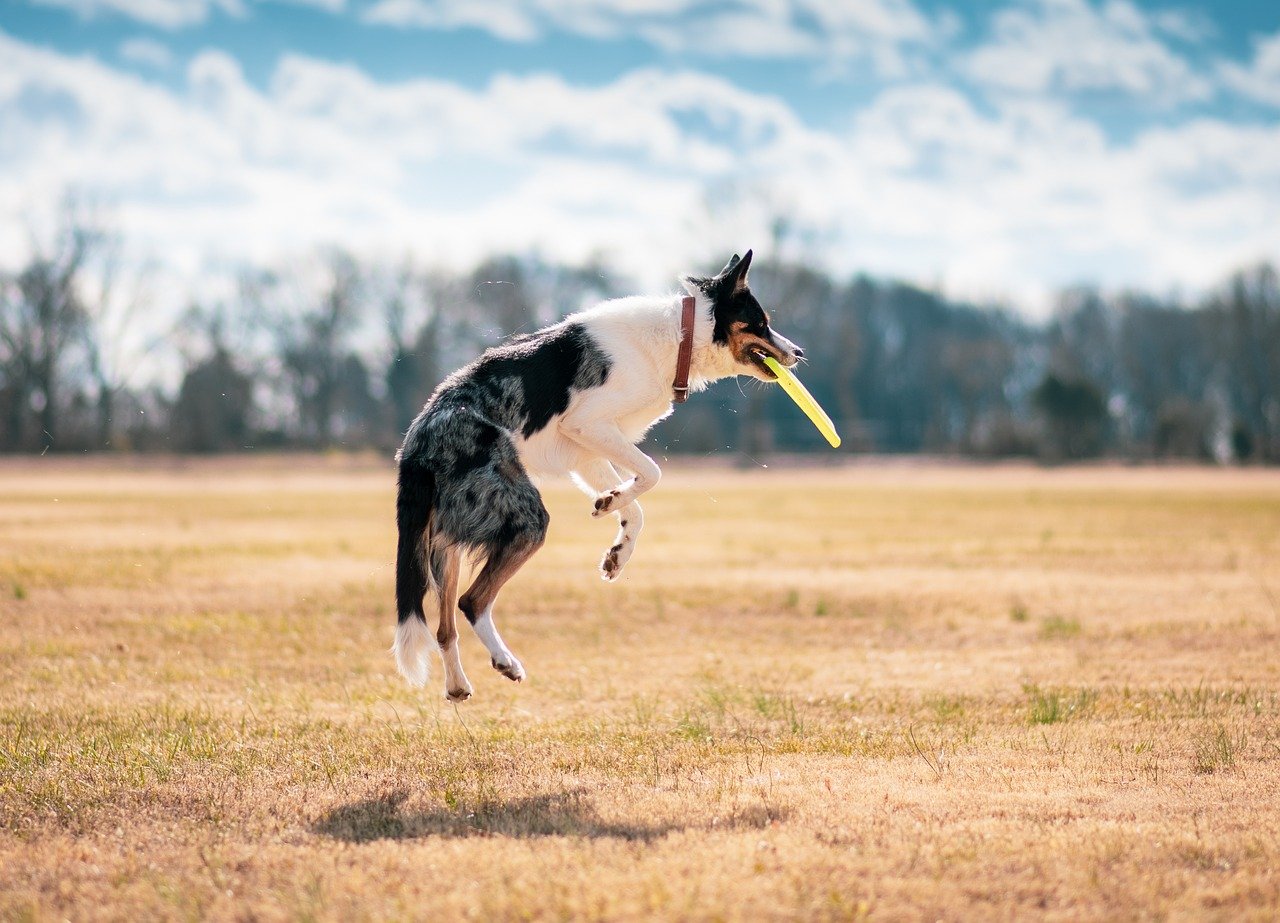
Grooming your rescue pet is not just about keeping them looking fabulous; it’s a vital part of their emotional and physical health. When we talk about effective grooming techniques, we’re diving into a world where the right tools and approaches can turn a potentially stressful experience into a relaxing ritual. Imagine your furry friend, once anxious and skittish, now happily wagging their tail during grooming sessions. Sounds dreamy, right? Let’s explore some key techniques that can make this transformation possible.
First and foremost, choosing the right tools is crucial. Every pet is unique, and their grooming needs can vary significantly based on their coat type and sensitivity. For instance, long-haired breeds may require a slicker brush to prevent mats, while short-haired dogs might do well with a rubber curry brush. It’s essential to invest in quality grooming tools that are designed for your pet’s specific needs. A good grooming tool can make all the difference, turning a chore into a bonding experience.
Next, let’s talk about positive reinforcement strategies. This technique is vital for easing anxiety during grooming sessions. Think of it this way: if you associate grooming with treats, praise, and love, your pet will start to see it as a positive experience rather than a dreaded task. For example, during grooming, you can give your pet a small treat every few minutes or offer lots of affection and praise when they remain calm. This creates a positive feedback loop, encouraging them to relax and enjoy the process.
Establishing a consistent grooming routine is another effective technique. Pets thrive on predictability, and having a set grooming schedule can help them feel more secure. Whether it’s a weekly brushing session or a monthly bath, consistency helps your pet understand what to expect, reducing their anxiety. You might even find that your pet looks forward to these sessions, much like how we look forward to our weekend rituals!
Finally, creating a calming environment during grooming can significantly enhance the experience. Make sure the grooming area is quiet and free from distractions. Soft music can help create a soothing atmosphere, and using calming scents, like lavender, can further ease your pet’s nerves. Remember, your energy matters too; if you’re calm and relaxed, your pet is likely to mirror that energy.
In summary, effective grooming techniques for rescue pets involve a combination of the right tools, positive reinforcement, a consistent routine, and a calming environment. By incorporating these strategies, you can transform grooming into a delightful experience, strengthening the bond between you and your furry friend.
- How often should I groom my rescue pet? It depends on the breed and coat type. Long-haired breeds may need grooming several times a week, while short-haired pets might only need it once a month.
- What if my pet is still anxious during grooming? If your pet continues to show signs of anxiety, consider consulting a professional groomer who specializes in handling anxious animals.
- Can grooming help with shedding? Yes! Regular grooming helps remove loose fur, reducing shedding and keeping your home cleaner.
When it comes to grooming rescue pets, selecting the right tools is crucial for both the pet's comfort and the effectiveness of the grooming process. Just like a painter needs the right brushes to create a masterpiece, a pet owner needs the appropriate grooming tools to ensure their furry friend looks and feels their best. The right tools can make all the difference in transforming a potentially stressful experience into a soothing and enjoyable one for both the pet and the owner.
First and foremost, consider the type of coat your rescue pet has. Different breeds come with various coat types, such as short, long, curly, or wiry, and each requires specific tools for optimal grooming. For instance, a short-haired dog may only need a simple bristle brush or a rubber grooming mitt to remove loose hair, while a long-haired cat might require a wide-toothed comb and a slicker brush to prevent matting. Using the wrong tool can lead to discomfort and even pain, which can exacerbate anxiety in an already stressed pet.
Moreover, it’s essential to think about the pet's sensitivity. Some pets may have sensitive skin or be prone to anxiety during grooming sessions. Therefore, opting for tools with rounded edges or soft bristles can help minimize any discomfort. For example, a gentle grooming glove can be an excellent choice for pets that are particularly skittish. It allows the owner to groom their pet while also providing a comforting touch, making the experience less intimidating.
Another factor to consider is the size of the tools. Using tools that are too large for your pet can be cumbersome and may lead to accidents. Conversely, tools that are too small might not be effective. Therefore, choosing the right size ensures that the grooming process is efficient and safe. For instance, a small comb may work well for a tiny breed, but a large brush is necessary for a big dog.
Here’s a quick reference table to help you choose the right tools based on your pet's coat type:
| Coat Type | Recommended Tools |
|---|---|
| Short Hair | Bristle Brush, Rubber Grooming Mitt |
| Medium Hair | Slicker Brush, Undercoat Rake |
| Long Hair | Wide-toothed Comb, Pin Brush |
| Curly Hair | Curly Coat Comb, Dematting Tool |
Lastly, don’t forget to invest in some additional grooming accessories like nail clippers, ear cleaners, and shampoo specifically formulated for pets. These accessories can further enhance the grooming experience, ensuring that your rescue pet not only looks great but also feels comfortable and cared for. Remember, grooming isn’t just about aesthetics; it’s about building trust and creating a bond with your pet. So, take your time to choose the right tools, and make grooming a positive experience that both you and your pet can enjoy!
- What tools do I need for grooming my rescue pet? The tools you need depend on your pet's coat type. Common tools include brushes, combs, nail clippers, and pet-safe shampoos.
- How often should I groom my rescue pet? Grooming frequency varies by breed and coat type, but generally, it's good to groom your pet at least once a week.
- Can grooming help reduce my pet's anxiety? Yes! Regular grooming can create a calming routine and strengthen the bond between you and your pet, helping to alleviate anxiety.
When it comes to grooming anxious rescue pets, positive reinforcement is a game changer. Imagine trying to coax a shy child into a new activity; you wouldn’t just push them into it, right? You’d offer encouragement and rewards to make them feel comfortable. The same principle applies to our furry friends. By using positive reinforcement during grooming sessions, you can create a safe and enjoyable experience that helps alleviate their anxiety.
First and foremost, it’s essential to establish a calm environment. Before you even pick up a brush, take a moment to let your pet acclimate to the grooming space. Use a gentle voice and soothing movements to help them feel at ease. Once they seem comfortable, you can begin the grooming process. Here’s where positive reinforcement comes into play. Each time your pet allows you to brush a section of their coat or tolerate the sound of clippers, reward them immediately with a treat or a gentle pat. This not only encourages them to stay calm but also builds a positive association with grooming.
It’s important to remember that every pet is unique. Some might respond better to verbal praise, while others may prefer treats. You can even combine both methods! For instance, you could say, “Good job!” while offering a tasty morsel. This dual approach reinforces the idea that grooming is a pleasant experience. Additionally, consider using high-value treats—those special snacks that your pet absolutely loves. These can be particularly effective in making grooming sessions something they look forward to.
Another effective strategy is to break the grooming process into smaller, manageable steps. Instead of trying to groom your pet all at once, focus on one area at a time. For example, if you’re brushing their fur, start with a few strokes and then reward them. Gradually increase the time spent grooming as they become more comfortable. This method not only reduces anxiety but also helps your pet learn that grooming is a predictable and safe activity.
Moreover, incorporating play into your grooming routine can also serve as a powerful motivator. After a successful grooming session, engage your pet in their favorite game or activity. This not only reinforces the positive experience but also helps them associate grooming with fun and excitement. Remember, the goal is to create a nurturing environment where your pet feels secure and loved.
To summarize, here are some effective positive reinforcement strategies for grooming anxious rescue pets:
- Establish a calm grooming environment.
- Use treats and praise to reward good behavior.
- Break the grooming process into smaller steps.
- Incorporate playtime after grooming to reinforce positive experiences.
By implementing these strategies, you can transform grooming from a stressful chore into a bonding experience that enhances your pet's emotional well-being. Just like building a bridge, it takes time and patience, but the connection you create will be worth every moment.
Q: How can I tell if my pet is anxious during grooming?
A: Look for signs such as trembling, hiding, or trying to escape. If they show these behaviors, take a break and try again later.
Q: What are some calming techniques I can use during grooming?
A: Try playing soft music, using calming scents, or offering treats to create a soothing atmosphere.
Q: How often should I groom my rescue pet?
A: It depends on the breed and coat type, but regular grooming—at least once a week—is generally recommended to keep them comfortable and healthy.

When it comes to caring for rescue pets, sometimes the best option is to seek professional help. While many pet owners feel confident grooming their furry friends, anxious pets may require a specialized approach that can be challenging to execute at home. Professional groomers possess a unique set of skills and experience that can significantly ease the grooming process for both the pet and the owner. They understand the nuances of animal behavior, which allows them to create a calming environment that can help reduce anxiety during grooming sessions.
So, how do you know when it's time to consult a professional groomer? There are several indicators that your pet may benefit from expert assistance. For instance, if your rescue pet exhibits excessive fear or aggression during grooming, or if they have a coat that is matted or tangled beyond your ability to manage, these are clear signs that professional help is warranted. It's essential to recognize the signs early to ensure your pet's comfort and well-being. Here are some common scenarios where seeking professional help may be beneficial:
- Your pet becomes extremely anxious or fearful when you attempt to groom them.
- They exhibit aggressive behavior, such as biting or scratching, during grooming.
- Their coat is severely matted or requires specialized tools and techniques to groom safely.
- You lack the time or knowledge to groom your pet properly.
Engaging a professional groomer not only helps reduce anxiety but also brings a host of additional benefits. Experienced groomers are trained to handle various breeds and temperaments, allowing them to tailor their approach to meet the specific needs of your rescue pet. They can also provide valuable advice on maintaining your pet's coat and skin health, ensuring that your furry friend stays comfortable and happy between grooming sessions. Moreover, the calming presence of a professional can help your pet build confidence, making future grooming sessions less stressful.
In summary, seeking professional help for grooming can be a game-changer for anxious rescue pets. It not only alleviates the stress of grooming but also fosters a more positive experience overall. By recognizing when your pet needs extra support and entrusting their care to a skilled groomer, you're taking a significant step towards enhancing their mental well-being and strengthening the bond between you and your beloved companion.
Q: How do I know if my rescue pet needs professional grooming?
A: Look for signs of anxiety or aggression during grooming, as well as the condition of their coat. If grooming becomes a stressful experience for you or your pet, it may be time to consult a professional.
Q: What should I expect from a professional grooming session?
A: A professional groomer will assess your pet's specific needs, use appropriate tools, and create a calm environment. They will also provide tips for maintaining your pet's coat and overall health.
Q: How can I help my pet feel more comfortable during grooming?
A: Gradually introduce grooming tools at home, use positive reinforcement, and establish a consistent routine. If your pet remains anxious, consider seeking professional help.
Knowing when to seek the help of a professional groomer for your rescue pet can be a game-changer in managing their anxiety and ensuring their overall well-being. It's not just about aesthetics; it's about providing a safe and comforting experience for your furry friend. If you notice your pet exhibiting signs of distress during grooming sessions at home, it might be time to consult a professional. For instance, if your pet is consistently trembling, growling, or attempting to escape during grooming, these behaviors indicate a level of anxiety that may be beyond your ability to manage alone.
Additionally, if your rescue pet has long or matted fur, the grooming process can become painful and stressful for them. In such cases, a professional groomer can handle these situations with care and expertise. They are trained to deal with sensitive pets and can often perform the grooming process more efficiently, reducing the time your pet spends in discomfort. Here are some specific scenarios where consulting a groomer is advisable:
- If your pet has a history of negative experiences with grooming.
- When your pet exhibits extreme fear or aggression during grooming.
- If you are unsure about how to properly groom your pet’s specific coat type.
- When your pet’s coat is severely matted or tangled.
- If you notice any skin issues or irritations that require professional attention.
Moreover, professional groomers not only provide grooming services but also offer valuable insights into your pet's behavior and health. They can help identify any underlying issues that may contribute to your pet's anxiety and recommend solutions tailored to your furry companion's needs. Remember, grooming should be a positive experience that fosters trust between you and your pet, so don't hesitate to seek professional help when you feel it's necessary.
Q: How often should I take my rescue pet to a groomer?
A: The frequency depends on your pet's breed, coat type, and individual needs. Generally, dogs with long or thick coats may need grooming every 4-6 weeks, while short-haired breeds might only require grooming every few months.
Q: Can grooming help with my pet's anxiety?
A: Yes! Regular grooming can create a calming routine and improve your pet's comfort level, ultimately reducing anxiety. It also strengthens the bond between you and your pet.
Q: What should I do if my pet doesn't like being groomed?
A: Try to make grooming a positive experience by using treats and praise. If your pet continues to show signs of distress, consider consulting a professional groomer who can help.
Q: Are there specific grooming tools I should use for anxious pets?
A: Yes, choosing the right tools is crucial. Look for gentle brushes, combs, and clippers that are designed for sensitive pets to minimize discomfort.
When it comes to our furry friends, especially those who have experienced the tumultuous journey of being rescued, professional grooming can be a game-changer. Why, you ask? Well, for starters, professional groomers are trained to handle pets that may be nervous or anxious. They possess a unique understanding of animal behavior, allowing them to create a calming environment during grooming sessions. This expertise is crucial for rescue pets, who may have had negative experiences in the past that make them wary of handling.
Moreover, professional groomers have the right tools and techniques to ensure that the grooming process is not only effective but also comfortable for the pet. For example, they can use specialized brushes that minimize discomfort for pets with sensitive skin or matted fur. This attention to detail helps to alleviate stress during grooming, which can otherwise be a daunting experience for an anxious animal.
Another significant advantage of professional grooming is the time-saving aspect. As pet owners, we often lead busy lives, and dedicating hours to groom our pets can be challenging. Professional groomers can efficiently handle the task, ensuring that pets receive the care they need without adding to the owner's workload. This efficiency is particularly beneficial for individuals who may not have the experience or confidence to groom their rescue pets effectively.
Additionally, regular visits to a professional groomer can help identify potential health issues early on. Groomers are trained to spot signs of skin conditions, parasites, or other health concerns that pet owners may overlook. By catching these issues early, owners can seek veterinary care promptly, ensuring their pets remain healthy and happy.
Lastly, the socialization aspect of professional grooming cannot be overlooked. For many rescue pets, exposure to different environments, people, and other animals is essential for their development. A professional grooming salon provides a safe space for pets to interact with others, helping them build confidence and reduce anxiety in social situations. This socialization is a crucial step in helping rescue pets adjust to their new lives.
In summary, the benefits of professional grooming are numerous and impactful. From providing a stress-free grooming experience to identifying health concerns and promoting socialization, professional groomers play a vital role in the well-being of rescue pets. If you're considering grooming options for your furry friend, don't hesitate to reach out to a professional who understands the unique needs of rescue animals.
- How often should I take my rescue pet to a professional groomer? It generally depends on the breed and coat type, but most pets benefit from grooming every 4-8 weeks.
- What should I look for in a professional groomer? Look for groomers who have experience with rescue pets, positive reviews, and a calm demeanor.
- Can I groom my rescue pet at home? Yes, but it’s important to use the right tools and techniques to avoid causing stress or discomfort.
- What if my pet is too anxious for grooming? Consult with a professional groomer who specializes in handling anxious pets or consider behavioral training.
Frequently Asked Questions
- Why is grooming important for rescue pets?
Grooming is essential for rescue pets as it promotes hygiene and comfort while also providing emotional benefits. Regular grooming helps alleviate anxiety by creating a calming routine and fostering a stronger bond between the pet and its owner.
- What are the common signs of anxiety in rescue pets?
Common signs of anxiety in rescue pets include physical symptoms like trembling, excessive panting, and hiding. Behavioral symptoms can include aggression, excessive barking, and destructive actions. Recognizing these signs is crucial for timely intervention.
- How can grooming help reduce anxiety in rescue pets?
Grooming can significantly reduce anxiety by providing a predictable routine, which helps pets feel secure. The process of grooming can also serve as a bonding experience, fostering trust between the pet and owner, which is vital for their emotional well-being.
- What grooming techniques are effective for anxious pets?
Effective grooming techniques for anxious pets include using gentle grooming tools, establishing a calming environment, and incorporating positive reinforcement strategies. These methods help create a positive association with grooming, making it a less stressful experience for the pet.
- When should I seek professional grooming services?
Consider seeking professional grooming services if your rescue pet shows signs of extreme anxiety during grooming at home or if you feel unsure about handling their grooming needs. Professional groomers are trained to manage anxious pets and can provide a more comfortable experience.
- What are the benefits of professional grooming for rescue pets?
Professional grooming offers several benefits, including access to specialized tools, techniques tailored for anxious pets, and the expertise of groomers who understand the unique needs of rescue animals. This can lead to a more positive grooming experience and improved emotional well-being for your pet.

